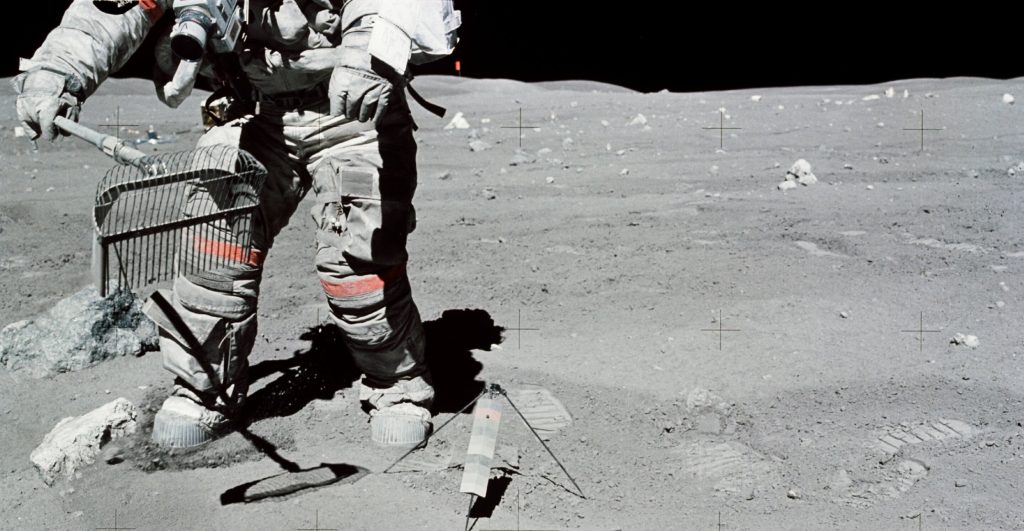Samples collected from the surface of the moon by the crew of Apollo 16 more than 50 years ago have helped scientists reconstruct billions of years of lunar history.
The research team’s findings, published in the journal Meteoritics & Planetary Science, are based on analysis of a distinct set of lunar breccias that have never been scrutinized in detail before.
Astronauts John Young, Charles Duke and Ken Mattingly brought more than 95 kg of samples from the moon back to Earth after their mission to the moon’s Descartes highlands in 1972.
Among those samples were “regolith breccias,” which form when moon dust—or regolith—is fused into rock by asteroid impacts. Once fused into a rock, these breccias preserve the geochemical composition of the regolith at the moment of its formation, which can be carefully analyzed for clues about how and when they were created.
The moon’s distinctive, heavily cratered appearance is the result of countless collisions with asteroids since its formation around 4.5 billion years ago. Over such extensive history, the matter of what happened and when it happened quickly becomes complicated.
The researchers, from the U.K. and the U.S., used sophisticated analytical mass spectrometry techniques to analyze the makeup of gases trapped in smaller chip samples, known as soil-like breccias. These samples, which were among those raked from the moon’s surface by the Apollo 16 crew, had never been subjected to mass spectrometry before.
Dr. Mark Nottingham led the research while working at the University of Manchester. He has since joined the University of Glasgow’s School of Geographical & Earth Sciences.
Dr. Nottingham, the paper’s lead author, said, “Mass spectrometry, which identifies molecules in samples and quantifies their relative abundance, can help us determine how much time the samples spent exposed on or near the moon’s surface. That helps give us a clearer idea of the history of impacts on this particular area of the moon.”
The team’s results help advance scientists’ understanding of how the surface of the moon has been changed by the solar wind and violently blasted by asteroids over the course of more than 2 billion years.
“Over the course of the samples’ time on the surface of the moon as regolith, they were exposed to varying amounts of solar wind—charged particles flowing from the sun which also carry traces of noble gases like argon and xenon—which built up on the outer layers of their mineral grains for millions of years before they were struck by an asteroid,” Dr. Nottingham added.
“The moon’s history is the Earth’s history too—the record of asteroid bombardments etched on its face and under its surface can help us understand the conditions of the early solar system which formed our planet as well as its closest neighbor.
“Unlike the Earth, however, the moon’s history is locked in geological time capsules on its surface, untouched by plate tectonics or erosion, which allows us to use cutting-edge technology like mass spectrometry to unlock their secrets.”

The research could also help future manned lunar missions pinpoint valuable natural resources to help moon bases be self-sustaining.
Previous research had analyzed the traces of noble gases within larger fragments of the Apollo 16 breccia samples, helping researchers separate the samples into two groups—”ancient,” aged between 3.8 and 2.4 billion years old, and “young,” which were formed between 2.5 and 1.7 billion years ago.
NASA provided the researchers with 11 moon samples for analysis. Nine of the samples revealed a wide range of exposure ages, from 2.5 billion years ago to less than 1 billion. This suggests they are made up of lunar soil from an area which has had a varied history of impacts, where some were exposed to the solar wind for billions of years, while others were dredged up to the surface by more recent impacts.
The team also found that two of the samples had much lower concentrations of noble gases, suggesting they were formed much more recently, and were perhaps exposed to solar wind for less than 1 million years. The team suggest that the impact which formed the nearby South Ray crater might have been the source of that sample.
Dr. Nottingham said, “This study establishes for the first time that soil-like breccias are their own distinct category, with their own histories to share. Combined with analysis of the ancient and young rocks recovered by Apollo 16, we can build a much more complete picture of the history of this part of the moon during the early solar system, where heavier impacts on the lunar surface in its first billion years or so gave way to less intense periods from 2 billion years ago or so.”
The research could also help inform ongoing efforts to send future missions to the moon in the near future, like NASA’s Artemis program, which plans to establish long-term human lunar habitats.
Dr. Nottingham said, “One of the challenges of establishing long-term habitats for humans on the moon is making decisions about how we can use the natural resources which await future missions so they don’t have to carry everything they’ll need with them from Earth.
“Studies like this add to our knowledge base about where useful elements like noble gases can be found in the lunar regolith, and how abundant they might be.
“It’s remarkable to think that the samples Apollo 16 brought back more than half a century ago still have secrets to reveal about the moon’s history, and that they could yet help shape how we explore the solar system in the decades to come.”
Researchers from NASA Goddard Space Flight Center, the Catholic University of America and Birkbeck College, London contributed to the study and are co-authors on the paper.
More information:
M. C. Nottingham et al, Constraints on the impact history of the Apollo 16 landing site: Implications of soil‐like breccia noble gas records, Meteoritics & Planetary Science (2024). DOI: 10.1111/maps.14244
Provided by
University of Glasgow

